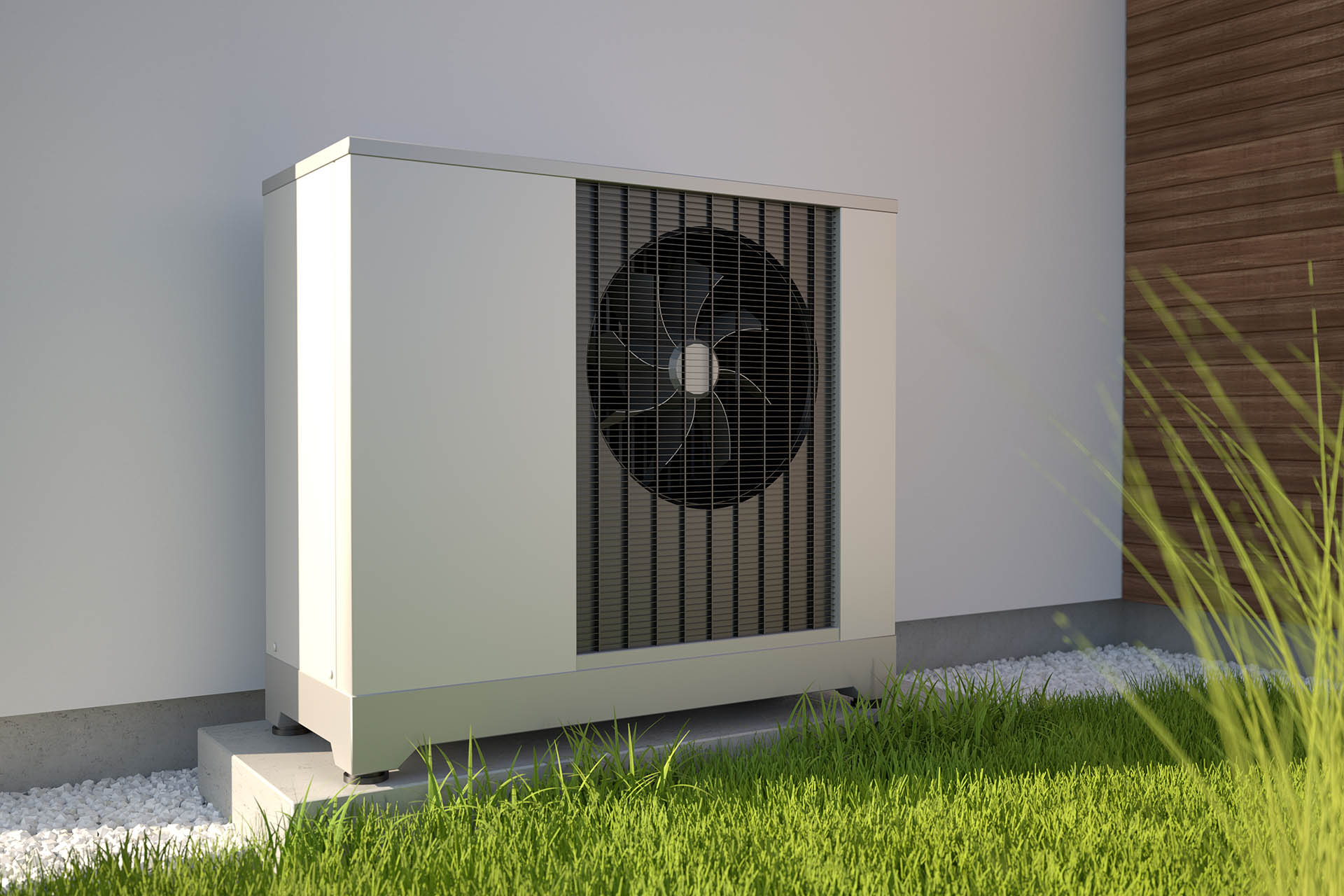Des records absolus de chaleur battus partout en France, la température du globe qui monte en flèche, une unique question se pose : comment faire redescendre le thermomètre ? Le choix semble s’orienter vers les climatiseurs : entre 2017 et 2020, le taux d’équipement des ménages français a presque doublé en passant de 14 à 25%[1]. Cette croissance ne semble pas fléchir car si déjà 10 climatiseurs sont vendus par seconde à travers le monde, l’IEA prévoit encore un triplement du stock mondial d’ici 2050. Mais climatiser c’est consommer de l’énergie, ce qui revient à émettre des gaz à effet de serre, donc finalement, à réchauffer… ? Alors la climatisation, quelles émissions ? quelles alternatives ? On étudie ça.
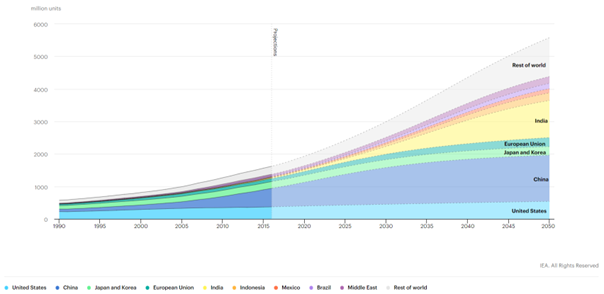
Stock mondial de climatiseurs, 1990-2050
L’impact de la climatisation sur le climat : Quand la clim réchauffe
La climatisation émet plus de 4 millions de tonnes de CO2eq par an en France. C’est presque la moitié des émissions du transport aérien du pays[2] et représente l’équivalent des émissions de 400 000 français. Mais pourquoi la climatisation émet-elle autant ?
Pour fonctionner, la climatisation utilise une quantité importante d’énergie. Cette consommation est d’autant plus importante que la température demandée est inférieure à la température extérieure. À titre d’exemple, l’énergie utilisée pour la climatisation des États-Unis est équivalente à l’ensemble de la consommation d’énergie de l’Afrique. En France, la climatisation serait responsable de 4,5% des émissions de gaz à effet de serre générées par la production d’électricité soit plus de 900 milliers de tonnes de CO2eq.
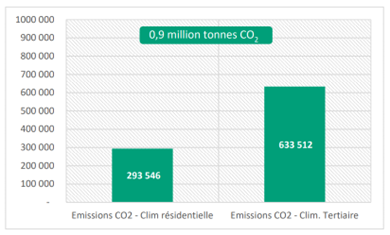
Les émissions de CO2 associées à la production d’électricité consommée par les systèmes de climatisation en 2020[3]
Mais ce n’est pas là l’essentiel des émissions de gaz à effet de serre des climatiseurs, la majorité de ces émissions est due aux fluides frigorigènes. Ces fluides sont indispensables au fonctionnement des machines mais sont aussi de puissants gaz à effet de serre et se trouvent toujours en partie libérés dans l’atmosphère. Le R-410 par exemple, largement présent dans les équipements de climatisation, a un pouvoir de réchauffement global (PRG) plus de 2000 fois supérieur à celui du CO2. L’ADEME estime ainsi que les pertes de ces fluides représentent plus de 3,4 millions de tonnes de CO2eq chaque année.
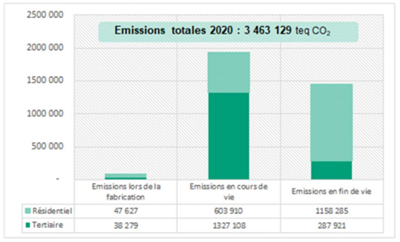
Pouvoir de réchauffement global des gaz frigorigènes perdus par les systèmes de climatisation (teqCO2 – 2020) 3
À cela il faudrait encore ajouter les émissions dues à la production des machines, à leur transport, leur installation, leur fin de vie… On dépasse donc vraisemblablement largement les 4 millions de tonnes de CO2eq par an et ce dans un marché en forte expansion.
Mais alors, dans un pays comme la France où les émissions de gaz à effet de serre doivent être divisées par 5 d’ici 2050[4], pouvons-nous nous passer de climatiseurs ?
Pourquoi se protéger de la chaleur ?
Il semble difficile de simplement se passer du refroidissement. En effet, se protéger de la chaleur a au moins 2 avantages majeurs : être plus productif et diminuer la mortalité lors des vagues de chaleur.
Avec le développement de la climatisation, la mortalité lors des périodes de fortes chaleurs a fortement diminué aux États-Unis dès les années 40 jusqu’à être divisée par 3 dans les années 70. L’importance du refroidissement lors des vagues de chaleur, en particulier pour les personnes âgées, n’est plus à démontrer. Au-delà de la mortalité, il a été démontré que la morbidité est elle aussi augmentée par les hautes températures sur de nombreuses maladies (respiratoires, cardiovasculaires, diabète, intestins…)[5].
La productivité semble elle aussi fortement impactée par la température. Selon une étude du Massachusetts Institute of Technology, elle chute de 1,5 points par degré au-dessus de 15°C. À l’échelle mondiale, une étude montre que la productivité décroit avec la température moyenne du territoire[6]. Plus de chaleur c’est donc moins de production.
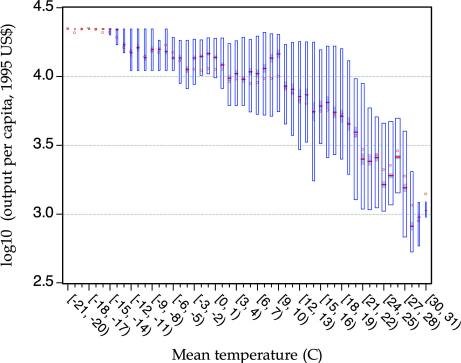
Production par habitant en fonction de la température moyenne6
On mesure ainsi combien il est difficile de se passer de refroidissement tant baisser la température de notre environnement de vie est bénéfique pour notre santé et notre productivité. Mais alors, comment rafraichir son intérieur sans faire monter la température du globe ?
Les alternatives à la climatisation
Concentrons-nous sur 2 cas d’application de la clim : le bureau et la voiture.
Un bureau moins chaud
Selon l’ADEME, la climatisation représente environ 5% des émissions de gaz à effet de serre des bâtiments résidentiels ou tertiaires. Une évolution à la hausse de cette estimation est néanmoins anticipée, du fait de sa forte corrélation au réchauffement climatique d’une part ; de la multiplication d’ilots de chaleur urbain d’autre part, avec des différentiels de températeur ville/campagne pouvant culminer à +4°C. À Phoenix (Etats-Unis) par exemple, les climatiseurs seraient responsables d’une augmentation de la température extérieure d’environ 2°C.

Visualisation des températures en 2008 pour une nuit de canicule[7]
Alors comment réduire la température, la facture énergétique et les émissions de gaz à effet de serre ? L’équation n’est pas simple mais admet quelques solutions étudiées notamment par l’ADEME[8] et l’OID[9].
Certaines installations permettent de diminuer grandement les besoins en rafraichissement :
- Végétaliser les toitures et les façades sont des solutions très efficaces (la différence de température peut atteindre 15°C) aux nombreux co-bénéfices (bien-être, support à la biodiversité, qualité de l’air, confort acoustique…) mais parfois coûteuses (750€/m² à la mise en place et 60€/m² d’entretien)
- Les protections solaires passives extérieures (de préférence) ont l’avantage d’être efficaces et peu coûteuses (filtres solaires, brises soleil, auvents, vitrages réfléchissants, films solaires…)
- Certains travaux peuvent être entrepris afin d’améliorer l’isolation du bâtiment ou d’augmenter l’albédo des murs et toitures. Les travaux de rénovation thermique permettent la diminution des besoins en refroidissement l’été mais aussi en chauffage l’hiver
Plusieurs bonnes pratiques permettent de diminuer les consommations simplement :
- Éteindre la climatisation lorsque les locaux sont inoccupés
- Préférer l’ouverture des fenêtres à la climatisation autant que possible (aérer les locaux le matin et le soir)
- Ne pas régler la climatisation à une température inférieure à 5°C par rapport à la température extérieure. En deçà, la surconsommation augmente fortement ainsi que le risque de chocs thermiques, irritations et maux de tête
Rouler au frais
En voiture, réduire son utilisation de climatisation permet de diminuer de 15% les émissions de gaz à effet de serre du véhicule selon l’ADEME[10]. L’air conditionné entraîne en effet une surconsommation de carburant de l’ordre de 1 L/100km pour les véhicules les plus récents et d’en particulier 2 L/100km en ville. Alors comment diminuer sa facture de carburant et son bilan carbone d’un même coup ?
En été, ouvrir les fenêtres en ville permet de rafraichir l’habitacle sans mettre en marche la climatisation. Sur l’autoroute, ouvrir les fenêtres ralentit le véhicule et entraîne donc une surconsommation de carburant de l’ordre de 5%. Cependant, utiliser la climatisation provoque une surconsommation de l’ordre de 0,4 L/100km[11]. Laisser les fenêtres ouvertes serait donc finalement moins consommateur en carburant que d’utiliser la climatisation.
Quoi qu’il en soit, quelques pratiques simples permettent de diminuer les consommations superflues :
- Éteindre la climatisation lorsqu’elle se met en route automatiquement mais qu’elle n’est pas utile
- Ne pas mettre la clim trop forte : moins de 5° d’écart avec la température extérieure pour éviter de trop fortes surconsommations
- Utiliser le mode recyclage pour respirer moins d’air pollué et consommer moins d’énergie (désactiver ce mode de temps en temps lors de longs trajets ou ouvrir les fenêtres)
- Allumer la climatisation seulement après quelques minutes de fenêtres ouvertes lorsque la voiture est restée au soleil
- Éteindre la climatisation 10 minutes avant la fin du trajet pour conserver la fraicheur sans consommation inutile
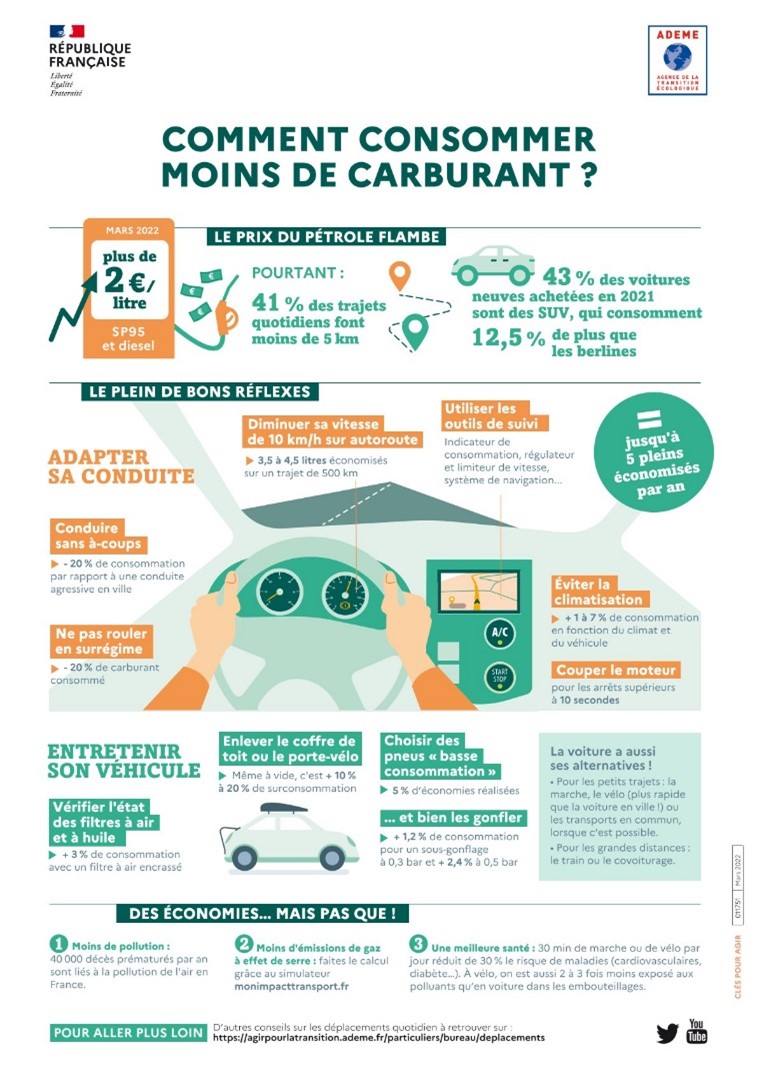
Comment consommer moins de carburant ?
Pour conclure
La climatisation représente 4 millions de tonnes de CO2eq par an en France sur un marché en grande croissance. Ces émissions sont majoritairement dues aux fuites de gaz frigorigène nécessaires à leur fonctionnement mais aussi à leur consommation d’énergie. Pour réduire les émissions personnelles et nationales de 80% d’ici 2050 et s’adapter au changement climatique, il est nécessaire de repenser le rafraichissement. Améliorer son utilisation de la climatisation en la mettant en marche uniquement lorsqu’elle est nécessaire et à une température raisonnable permet déjà d’améliorer son bilan. Pour réduire voire annuler le besoin en climatisation, certaines mesures pratiques peuvent être réalisées telles que la végétalisation de façade et de toiture, l’installation de protections solaires ou la rénovation thermique. Enfin, il faudra dorénavant se préoccuper d’avantage des enjeux thermiques des bâtiments et des villes dès leur construction pour ne pas souffrir des variations de températures de plus en plus importantes. In fine, que ce soit au travail, en voiture ou chez soi, les alternatives existent pour sauver son portefeuille et la planète !
[1] Agence de la Transition écologique (ADEME), La climatisation : vers une utilisation raisonnée pour limiter l’impact sur l’environnement, 2021
[2] Ministère de la Transition écologique et de la Cohésion des territoires, Ministère de la Transition énergétique, Les émissions gazeuses liées au trafic aérien, 2021
[3] Modélisation ADEME – CODA Stratégies
[4] Ministère de la Transition écologique et de la Cohésion des territoires, Ministère de la Transition énergétique, Stratégie Nationale Bas-Carbone (SNBC), 2021
[5] Bart Ostro, Stephen Rauch, Rochelle Green, Brian Malig, Rupa Basu, The Effects of Temperature and Use of Air Conditioning on Hospitalizations, American Journal of Epidemiology, 2010
[6] William D. Nordhaus, « Geography and macroeconomics: New data and new findings », Proc Natl Acad Sci U S, 2006
[7] Groupe Descartes, 2009
[8] https://expertises.ademe.fr/professionnels/entreprises/performance-energetique-energies-renouvelables/lenergie-bureaux/dossier/ventilation-climatisation/conseils-agir
[9] Observatoire de l’Immobilier Durable, Guide des actions adaptatives au changement climatique, 2022
[10] Agence de la Transition écologique (ADEME), La climatisation automobile : Impact énergétique et environnemental, 2020
[11] Agence de la Transition écologique (ADEME), La climatisation automobile : Impact énergétique et environnemental, 2020



